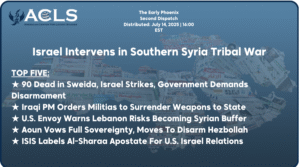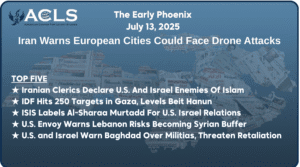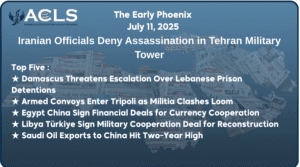By Catherine Perez-Shakdam
Iran’s calculated expansion for regional control, employing various proxies such as Hezbollah in Lebanon, or the Houthis in Yemen, while simultaneously running deceptive diplomatic channels, presents an urgent and complex challenge to both regional stability and U.S. strategic interests. As the Islamic Republic continues to extend its sphere of influence into new fronts like Africa and Latin America through the Islamic Revolutionary Guard Corps (IRGC), a comprehensive examination of Iran’s activities becomes imperative within the broader context of American strategic imperatives.
In the complex realm of international geopolitics, Iran’s multi-layered approach, often executed through proxy entities, continues to be a subject of intense scrutiny among policymakers and scholars. “Iran’s network of proxies is its single most important instrument of statecraft,” argues Phillip Smyth, a Soref Fellow at the Washington Institute in The Shiite Jihad in Syria and Its Regional Effects. This complex strategy focuses on exerting control over key infrastructure points in targeted countries, including border crossings, seaports, and airports. Lebanon and Yemen exemplified by the critical role played by Hezbollah and the Houthis, stand as primary case studies that elucidate Iran’s multi-dimensional tactics.

Vali Nasr, an esteemed expert in Middle Eastern affairs, aptly identifies the Lebanese Civil War as a turning point for Iran’s regional strategy in his book, The Shia Revival. Hezbollah, initially formed as a reaction to the Israeli invasion of Lebanon in 1982, has evolved from a paramilitary group into a formidable political force, backed substantially by Iran’s Islamic Revolutionary Guard Corps (IRGC). “Hezbollah is a state within a state, and it couldn’t exist without Iranian help,” emphasizes Matthew Levitt, from the Washington Institute for Near East Policy in Hezbollah Finances: Funding the Party of God.
The reach of Iran’s ambitions is not confined to the Middle East. As highlighted by its forays into new regions like Africa and Latin America, the Islamic Republic is actively working to extend its sphere of influence. “Iran’s relationship with Venezuela, for instance, demonstrates Tehran’s ability to move beyond its traditional geographic and cultural comfort zone,” writes Stephen Johnson Tehran’s Strategic Influence in the Americas.
This multi-front expansionist agenda poses an intricate challenge to U.S. strategic interests, calling for a nuanced yet decisive American response. “Iran’s increasing influence represents one of the most significant challenges to the U.S. strategic posture in the Middle East,” argues Michael Eisenstadt, director of the Military and Security Studies Program at the Washington Institute in The Strategic Culture of the Islamic Republic of Iran. Thus, a comprehensive examination of Iran’s activities is not merely an academic endeavor; it is a strategic imperative for the United States, integral to safeguarding its global interests and ensuring regional stability.
Iran’s Diplomatic Games
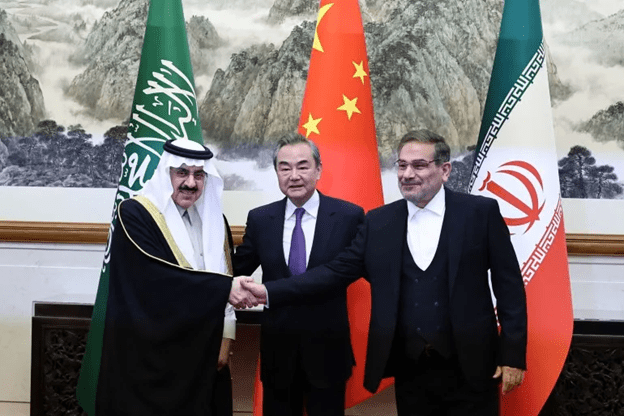
The announcement on March 10 of a tripartite agreement involving Saudi Arabia, Iran, and China was a seismic event that deserves close scrutiny. The prevailing narrative has largely been centered on China’s augmented role in the Middle East as part of its broader geopolitical strategy. Yet, such an assessment potentially overlooks Saudi Arabia’s nuanced motivations, which cannot be reduced to merely a hedging strategy against a retreating United States or an exercise in global power balancing.
This renewed diplomatic engagement, achieved after seven years of diplomatic and military standoffs and predicated on secretive bilateral talks spanning two years, was a calculated move by Riyadh. It was designed to test the waters with Iran, treating it as an equal stakeholder in the regional balance of power. This was a direct challenge to Iran’s longstanding claim to de facto regional leadership, a status Tehran has sought to cement through a blend of diplomatic maneuvers and military interventions via proxy actors.
Yet, Iran’s reaction was swift and multi-layered, embodying a ‘dual-track’ approach that has become a hallmark of its foreign policy. On the surface, Iran welcomed the olive branch, engaging in diplomatic exchanges that seemed to herald a new phase in regional relations. However, almost concurrently, Iran ramped up its activities through proxy networks, most notably escalating tensions to potentially thwart Saudi Arabia’s budding rapprochement with Israel. This action serves as a pointed reminder of Iran’s adeptness at pursuing a parallel agenda—one of subtle diplomatic engagements shadowed by a more aggressive regional strategy.
The complexities and risks presented by Iran’s strategic bifurcation demand an urgent rethinking not just from Saudi Arabia but also from the broader international community. Far from simplifying the regional dynamic, this recent tripartite agreement has added another layer of intricacy, emphasizing the imperative for a meticulously crafted, comprehensive strategy that takes into account the full spectrum of Iran’s regional ambitions.
As Saudi Arabia seeks to recalibrate its foreign policy to buttress its ambitious Vision 2030 plan, the kingdom’s recent de-escalation efforts with Iran represent more than mere diplomatic prudence. Given the vast financial commitments necessitated by Vision 2030, Riyadh simply cannot afford an escalation with Tehran that could imperil funding, spook foreign investors, and hamper its aspirations to transform into a regional nexus for industries like cloud computing, trade, and logistics.
The Chinese-brokered détente coincided with a period of resurgent Saudi influence, both economically and diplomatically. Bolstered by high oil prices, Riyadh has been able to press ahead with its economic reforms, reinforcing its ‘Saudi First’ diplomatic posture to rehabilitate its global standing. This stance has been further fortified by an evolving defense paradigm with the United States and Israel, both of which perceive Iran as a regional destabilizer. Moreover, Riyadh’s apparent clandestine support for Iranian opposition media arms it with a potent bargaining chip.
Conversely, Iran is grappling with widespread domestic discontent and debilitating international sanctions, elevating its need for economic sustenance from potential benefactors, including Saudi Arabia. While this seems to provide Riyadh with a strategic advantage, Iran’s history of regional aggression—underscored by incidents such as the 1996 Khobar Tower attacks, the 2019 offensives on Saudi oil facilities, and more recently this September the attack on Saudi Arabia’s souther borders which saw the death of several Bahraini nationals—remains a lingering concern. Additionally, Iran’s accelerating uranium enrichment activities could escalate its deterrent capabilities, effectively authorizing it to pursue more aggressive measures against its neighbors.
While China may be facilitating a diplomatic softening between the two Gulf powers, its role as an economic patron and diplomatic mediator doesn’t guarantee its willingness to intercede should Iran opt to violate this newfound truce. Therefore, Saudi Arabia’s engagement with Iran, seen as an attempt to challenge Tehran’s self-proclaimed brokerage power in the region, runs parallel to Iran’s own agenda of stealthy expansionism—revealing a delicate interplay of strategic overtures and concealed intentions on both sides.
Iran’s Regional Play

Iran’s strategy in the Middle East has, over recent years, increasingly pivoted around the use of intermediary actors, particularly militant groups, to achieve its broader strategic objectives. This approach has served multiple purposes for Iran, such as providing plausible deniability in operations and allowing for a cost-effective way to challenge regional rivals and Western interests.
A salient example of this is Hezbollah’s prominent role in Lebanon. Created in the early 1980s with significant support from Iran’s IRGC, Hezbollah has since evolved from a militant resistance group into a dominant political and military force in Lebanon. This transformation did not occur in isolation but was a calculated move. As the Tony Blair Institute points out, “the IRGC has made it a mission to export the Iranian revolution, and Hezbollah serves as its primary model.” Hezbollah’s control over crucial parts of the Lebanese state, notably its infrastructure, demonstrates Iran’s successful implantation of an intermediary actor that advances its interests.
Moreover, it’s not just the direct influence of Hezbollah that poses a challenge. The group’s deep ties and influence within the Lebanese Armed Forces and other state apparatuses underscore the extent of Iran’s reach. The danger this poses to regional stability is manifold. As the Institute mentions, “Hezbollah’s arsenal, reportedly boasting over 150,000 rockets and missiles, surpasses that of most national armies.” The mere existence of such a formidable non-state actor in a volatile region increases the risks of conflict escalation, often independent of the traditional checks and balances that state actors might consider.
But Lebanon is just a piece of the puzzle. The IRGC’s footprint has been expanding beyond the immediate Middle East. There’s growing evidence to suggest Iran’s influence is stretching into areas such as Africa and Latin America. In a development that has profound implications for global security, Iran’s naval commander announced on the 11th of January plans to deploy Iranian warships in the Panama Canal by year’s end 2023. To heighten concerns, official documents from the Brazilian navy have recently emerged, granting permission for two Iranian naval vessels to dock in Brazil. This calculated move by Iran not only challenges the security equilibrium of the Western world but also imperils the stability and integrity of a trade route that is of paramount global significance.
Iran’s recent overtures towards control of maritime security in the region further highlights Tehran’s ambitions to erode at the current status quo and consolidate its control over energy routes.
U.S.-Iranian discord has persisted as a recurring theme for decades. Maritime activities in the region largely operate under the jurisdiction of the Islamic Revolutionary Guard Corps’ (IRGC) navy, although Iran’s conventional naval forces share this responsibility. In the context of external pressures, Iran has frequently issued threats to close off the Strait of Hormuz—a vital global choke point, responsible for the passage of a substantial fraction of the world’s oil supply.
 In April Iranian Defense Minister Mohammad Reza Ashtiani introduced Iran’s newest ‘maritime project’ during an assembly of SCO Defence Ministers in India. He mooted the creation of a “Shanghai Maritime Security Belt“—a mechanism aimed at safeguarding maritime lanes and trade among SCO member states. Though details remain ambiguous, Ashtiani stressed the significance of the Indian Ocean in global trade, positing that these waterways face threats emanating from the West and NATO’s ‘expansionist’ policies.
In April Iranian Defense Minister Mohammad Reza Ashtiani introduced Iran’s newest ‘maritime project’ during an assembly of SCO Defence Ministers in India. He mooted the creation of a “Shanghai Maritime Security Belt“—a mechanism aimed at safeguarding maritime lanes and trade among SCO member states. Though details remain ambiguous, Ashtiani stressed the significance of the Indian Ocean in global trade, positing that these waterways face threats emanating from the West and NATO’s ‘expansionist’ policies.
This Iranian initiative unveils itself at a moment fraught with escalating tensions between Tehran and Washington, along with their respective allies. The nexus of these tensions remains primarily in the maritime domain, encompassing the Persian Gulf, the Strait of Hormuz, and the Sea of Oman—a zone through which a fifth of global oil supplies circulate. Just a day prior to the SCO meeting, the U.S. authorities accused Iran of seizing an oil tanker in the Sea of Oman, ostensibly in retaliation for the U.S.’s own apprehension of an Iranian tanker under the guise of enforcing sanctions.
Such maritime skirmishes are not isolated incidents; rather, they represent a broader pattern of confrontations in the wake of the U.S.’s unilateral withdrawal from the 2015 nuclear accord in 2018 and the ensuing re-imposition of sanctions on Iran. As recently reported, Iranian forces seized two Greek tankers in May 2022. To compound matters, U.S. officials claim that, over the last two years, Iran has captured eight and assaulted seven vessels. These dynamics necessitate a renewed focus on maritime security as a crucial aspect of international diplomacy and strategic policy-making.
Iran, through the strategic use of the IRGC and intermediary actors has crafted an effective strategy to challenge U.S. interests and regional stability far beyond its borders. The international community, and particularly the U.S., needs to consider these challenges urgently and holistically, lest they allow Iran to solidify its influence in these new frontiers.
Iran’s broader geopolitical ambitions
The evolving chronology of Hezbollah’s activities in Lebanon manifests as compelling evidence of Iran’s strategic investment in shaping the region to its own geopolitical advantage. Iran has systematically expanded Hezbollah’s capacities to align with its broader regional ambitions. In his book, Hezbollah: A Short History Professor Augustus Richard Norton posits that Hezbollah is a “janus-faced” organization in the middle of an incomplete metamorphosis from extremism to mundane politics, an evolution whose outcome is far from certain. Beginning as a terrorist cat’s-paw of Iran, Hezbollah has since transformed itself into an impressive political party with an admiring Lebanese constituency.
Beginning in the early 2000s, Hezbollah penetrated the Lebanese political landscape, obtaining parliamentary and cabinet representation. This strategic foray into governance enabled Hezbollah “to steer Lebanese state institutions to serve its wider objectives,” noted Norton (Norton, 2007).
Hezbollah has long considered Lebanon’s land and sea border crossings, and especially Beirut’s Rafic Hariri International Airport, as vital components of its strategic framework. As it currently stands, the principal aim for Hezbollah is to establish its dominion over this key international airport—a pursuit vigorously led by Hashem Safi al-Din, the Head of Hezbollah’s Executive Council, and Haj Fadi (Muhammad Jaafar Qusayr), who oversees Unit 4400, responsible for the group’s smuggling operations.
To achieve this end, Hezbollah is deploying an intricate strategy that leverages key individuals within Lebanon’s government, security apparatus, and seemingly the private business sector as well. Utilizing these figures as intermediaries or proxies, Hezbollah is actively advancing its campaign to secure control over the airport.
This calculated move underscores Hezbollah’s keen interest in asserting its influence over vital elements of Lebanon’s infrastructure.
Since 2011, Hezbollah’s involvement in the Syrian civil war has extended its military reach to border regions, further bolstering its influence beyond Lebanese territory. In more ways than one Hezbollah’s extended military footprint in Syria enhances its strategic importance to Iran.
Iran’s hand in shaping these developments is far from subtle. It’s worth noting that Iran’s strategic wisdom is exhibited not just in Lebanon but also stretches to Iraq and Yemen. For example, in Iraq, Iranian-backed Shiite militias are key players. Malcolm Kerr notes in his research how Iran’s influence over these militias has allowed it to exert considerable control over Iraq’s border crossings.
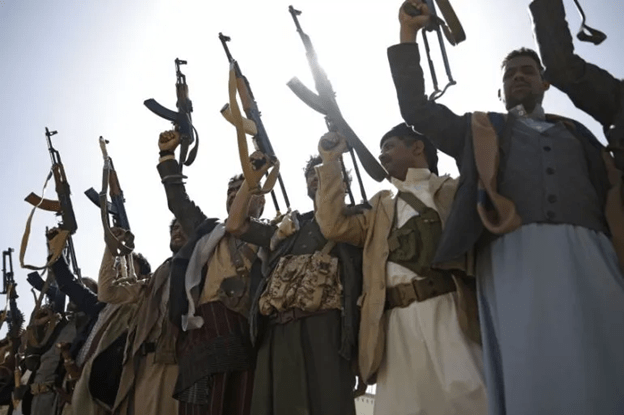
Likewise, in Yemen, Iran’s support of the Houthi rebels mirrors its backing of Hezbollah. Just as in Lebanon, Iran extends its strategic arm in Yemen through proxies, particularly in their quest to control vital ports.
In sum, Iran’s adept use of asymmetric warfare, coupled with sophisticated diplomatic maneuvers, has significantly reshaped the geopolitical dynamics of the Middle East. This multi-pronged approach underscores Iran’s strategic acumen in leveraging state and non-state actors to further its regional ambitions. Given the significant ramifications this holds for regional stability and U.S. interests, there is an urgent need for a nuanced understanding of Iran’s regional strategies, achieved in part through its proxy Hezbollah, in order to effectively address these burgeoning challenges.
The chronology of Hezbollah’s activities and its increasing influence in Lebanon provides compelling evidence of the group’s systematic expansion under the auspices of the Islamic Republic of Iran. These developments carry significant regional implications, particularly concerning Iran’s broader geopolitical ambitions.
In the early 2000s, Hezbollah firmly entrenched itself in Lebanese politics, securing representation in both the Lebanese parliament and cabinet (Norton, 2007). This political maneuvering was pivotal in establishing Hezbollah as a formidable actor in Lebanese governance, granting it the means to pursue its objectives through state institutions.
By 2005, Hezbollah had assumed control over the security apparatus at Beirut airport (Dagher, 2009). This control not only conferred substantial influence over the movement of goods and individuals but also underscored the group’s strategic positioning within vital infrastructural elements, closely aligning with Iran’s regional strategy.
The capture of two Israeli soldiers by Hezbollah in 2006 triggered a month-long conflict with Israel, cementing Hezbollah’s status as a potent military and political force in Lebanon (Harel, 2007). This military display not only showcased Hezbollah’s capabilities but also fortified its influence within the country.
Hezbollah’s takeover of West Beirut in 2008 and the subsequent Doha Agreement granted the group significant sway over Lebanese politics (Gerges, 2010). This episode underscored its capacity to assert control over pivotal regions of the country and its unwavering commitment to achieving its objectives.
Hezbollah’s engagement in Syria’s civil war since 2011 further bolstered its military prowess, including control over border regions (Byman, 2015). This expansion allowed Hezbollah to establish a foothold in Syria, extending its influence beyond Lebanon’s borders.
By 2019, Hezbollah had extended its influence over Lebanon’s seaports, particularly Beirut and Tripoli (Jones, 2020). This development marked another critical milestone in its quest to control essential infrastructure, including seaports.
Hezbollah’s command over Syria’s border crossings, an outgrowth of its involvement in the Syrian conflict, attests to Iran’s strategic acumen (BBC, 2017). Iran recognized Syria’s pivotal role in its regional ambitions and supported Hezbollah’s engagement in Syria through military training and financial assistance.
Iran’s ability to avoid foreign intervention while advancing its agenda through Hezbollah can be attributed to a multifaceted strategy. Firstly, Iran employed asymmetric warfare tactics and relied on proxy groups like Hezbollah to conduct operations in Syria, minimizing direct Iranian involvement (Middle East Policy Council, 2014). Secondly, Iran undertook extensive lobbying endeavors to garner political support from sympathetic governments, thereby safeguarding its interests (Barkan, 2018). This diplomatic finesse enabled Iran to navigate regional conflicts without attracting direct foreign intervention.
Iran’s calculated maneuvering, reinforced by its investments in Hezbollah’s military and political capabilities, has facilitated the group’s expansion across Lebanon’s critical infrastructure and beyond, encompassing Syria. This strategic approach has far-reaching implications for regional stability and poses significant challenges to U.S. interests. A comprehensive comprehension of Iran’s regional aspirations and its reliance on proxies like Hezbollah is indispensable in addressing these intricate challenges within the Middle East.
These developments underscore Hezbollah’s multifaceted approach to consolidating control over Lebanon’s critical infrastructure and political landscape. Iran’s recognition of Hezbollah as a potent proxy and its substantial investment in the group’s military and political capabilities have been pivotal in these achievements. These actions hold profound regional implications, running counter to U.S. interests, and reshape the geopolitical dynamics of the Middle East. Effectively addressing these challenges necessitates a thorough understanding of Hezbollah’s evolution and strategic positioning within Lebanon and the broader regional context.
Iran’s comprehensive strategy, enacted through proxy groups, to seize control of critical infrastructure, including border crossings, airports, and seaports, is not confined to Lebanon. This multifaceted approach finds replication in Iraq and Yemen, albeit with context-specific variations. A comparative analysis illuminates Iran’s overarching strategy, which significantly impacts regional dynamics and U.S. interests.
In Iraq, the Islamic Republic of Iran has deftly followed a similar playbook. The consolidation of power by Shiite militias with Iranian affiliations has enabled Iran to exert influence over border crossings, particularly those connecting Iraq to Iran (Mansour, 2020). These militias’ involvement in securing key infrastructure has allowed Iran to effectively control the flow of goods and personnel, mirroring its actions in Lebanon.
Yemen, embroiled in a protracted conflict, witnessed Iran supporting Houthi rebels in their quest for power. These rebels have sought to gain control over strategic infrastructural elements, including ports (Al-Jabri, 2019). Iran’s backing of the Houthis mirrors its support for Hezbollah in Lebanon, aiming to extend its influence through proxy groups.
The significance of Iran’s control over critical infrastructure within target nations cannot be overstated. Not only has it bolstered Iran’s regional hegemony, enabling it to shape the economic and political landscapes of these countries, but it has provided Tehran with the means to exert pressure and coercion on neighboring states, granting it considerable leverage in regional dynamics.
Iran’s astute diplomatic maneuvering thus far, has resulted in tacit agreements with global powers, shielded its regime from significant international pushback.
The danger posed by Iran’s expansionist agenda, manifested through proxy-controlled infrastructure, is amplified in the contemporary geopolitical landscape. Iran’s influence, bolstered by an increasingly assertive posture, raises concerns regarding regional stability and U.S. interests. As Iran seeks to replicate its Lebanese and Iraqi successes, these dynamics become more pronounced.
Iran’s consistent strategy of controlling critical infrastructure through proxies transcends Lebanon and finds replication in Iraq and Yemen. Understanding this schema is paramount, as it underscores Iran’s regional ambitions and its ability to shape the geopolitical landscape. The failure to curb Iran’s influence lies in its adept use of proxies and diplomatic finesse. In today’s context, as Iran extends its reach, the implications for regional stability and U.S. interests are more pronounced than ever, demanding a nuanced and proactive approach to address these challenges effectively.

